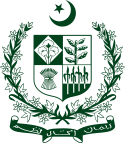
Back Organisation juridictionnelle au Pakistan French पाकिस्तान की न्यायपालिका Hindi ਪਾਕਿਸਤਾਨ ਦੀ ਨਿਆਂਪਾਲਿਕਾ Punjabi پاکستان دی عدلیہ PNB پاکستان کی عدلیہ Urdu
 | |
| Service overview | |
|---|---|
| Formerly known as | Federal Judiciary |
| Founded | 14 August 1947 |
| Country | |
| Controlling authority | Supreme Court High Court Federal Shariat Court |
| Legal personality | Judiciary |
| Duties | Justice Administration Public Interest Litigation Guardian of the Constitution |
| Hierarchy of Courts in Pakistan | 1. Supreme Court 2. High Court/Federal Shariat Court 3. District Court |
| Post Designation | Justice Judge Magistrate - Judicial & Executive |
| Selection / Appointment | 1. Judicial Commission of Pakistan for the Supreme & High court judges 2. Governor for Subordinate Judiciary (after passing the service exam) |
| Head of Judiciary | |
| Chief Justice of Pakistan | Justice Yahya Afridi |
 |
|---|
|
|
The judiciary of Pakistan is the national system of courts that maintains the law and order in the Islamic Republic of Pakistan. Pakistan uses a common law system, which was introduced during the colonial era, influenced by local medieval judicial systems based on religious and cultural practices. The Constitution of Pakistan lays down the fundamentals and working of the Pakistani judiciary.
Pakistan has two classes of courts: the superior (or higher) judiciary and the subordinate (or lower) judiciary. The superior judiciary is composed of the Supreme Court of Pakistan, the Federal Shariat Court and five High Courts, with the Supreme Court at the apex. There is a High Court for each of the four provinces as well as the federal capital. The Constitution of Pakistan entrusts the superior judiciary with the obligation to preserve, protect and defend the constitution.[1] The autonomous and disputed territories of Gilgit-Baltistan and Azad Kashmir have separate judicial systems from the main Pakistani system.[2][3][4][5]
The independence of the Pakistani judiciary has changed over time. Whereas the judiciary used to defer to the Pakistani military, which is a dominant actor in Pakistan's politics, the judiciary has increasingly competed with and confronted the military.[6]
The subordinate judiciary consists of civil and criminal district courts, and numerous specialized courts covering banking, insurance, customs and excise, smuggling, drugs, terrorism, taxation, the environment, consumer protection, and corruption. The criminal courts were created under the Criminal Procedure Code 1898, during the British Raj, and the civil courts were established by the West Pakistan Civil Court Ordinance 1962. There are also revenue courts that operate under the West Pakistan Land Revenue Act 1967. The government may also set up administrative courts and tribunals for exercising exclusive jurisdiction in specific matters.[1]
As of 2017, Pakistan's judiciary is suffering from a backlog of two million cases, with lawsuits taking an average of nearly ten years to resolve.[7] According to some estimates, 90 percent of civil cases involve land disputes, owing to Pakistan's lack of a proper land register.[7]
- ^ a b Dr. Faqir Hussain (Registrar) (15 February 2011). "The Judicial System of Pakistan" (PDF). Supreme Court of Pakistan. Archived from the original (PDF) on 6 February 2017. Retrieved 24 December 2013.
- ^ "Gilgit-Baltistan: A question of autonomy". The Indian Express. 21 September 2009. Retrieved 14 April 2017.
- ^ "Article 247(7)". Constitution of the Islamic Republic of Pakistan. Pakistani.org. 1973. Retrieved 24 December 2013.
- ^ "Section 42 (Supreme Court of Azad Jammu and Kashmir) and Section 43 (High Court)". AJK Interim Constitution Act, 1974 (PDF). Government of Azad Kashmir. Archived from the original (PDF) on 13 October 2013. Retrieved 24 December 2013.
- ^ Gilgit-Baltistan (Empowerment and Self-Governance) Order, 2009, Article 60 (Supreme Appellate Court) and Article 69 (Chief Court)
- ^ Kureshi, Yasser (2022). Seeking Supremacy: The Pursuit of Judicial Power in Pakistan. Cambridge University Press. ISBN 978-1-316-51693-5.
- ^ a b "Pakistan is "mainstreaming" misogynist tribal justice". The Economist. 13 October 2017.

